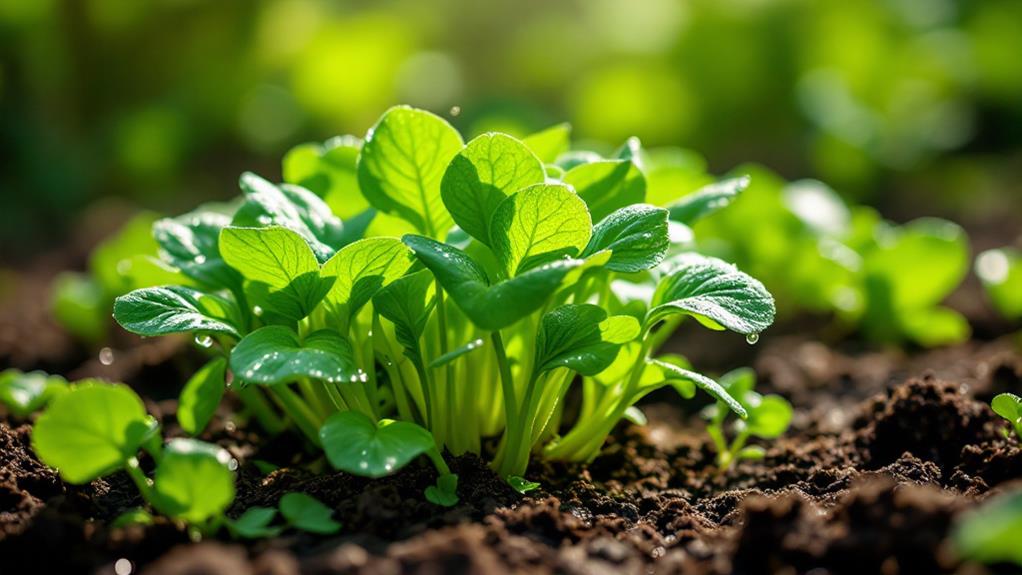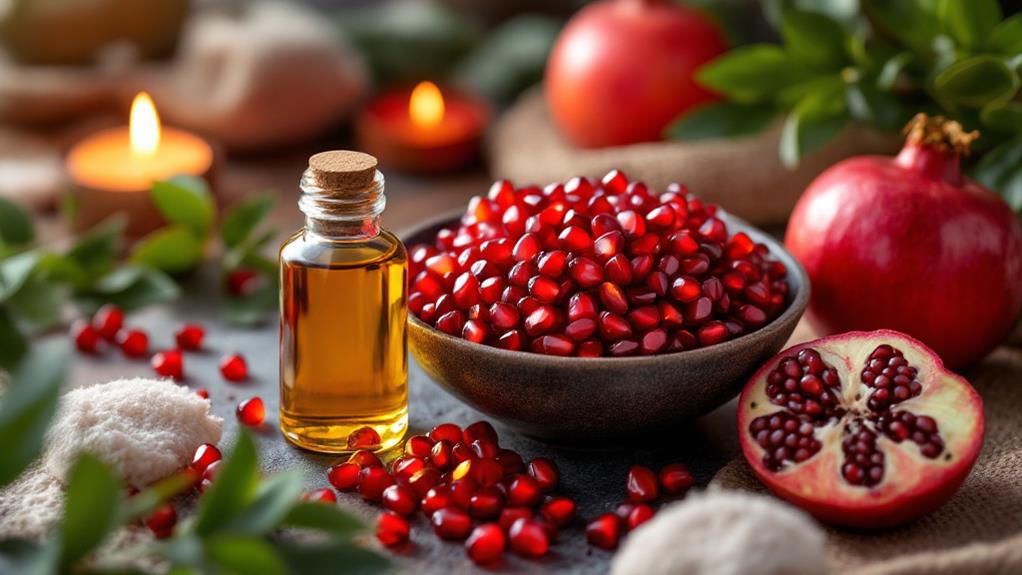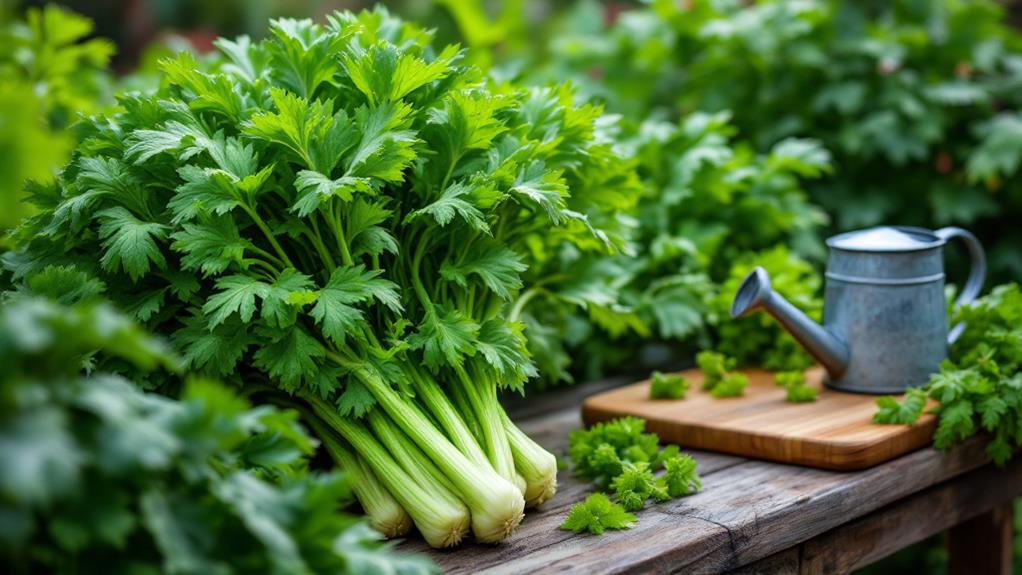How to Store Fresh Produce to Improve Shelf Life: Essential Tips
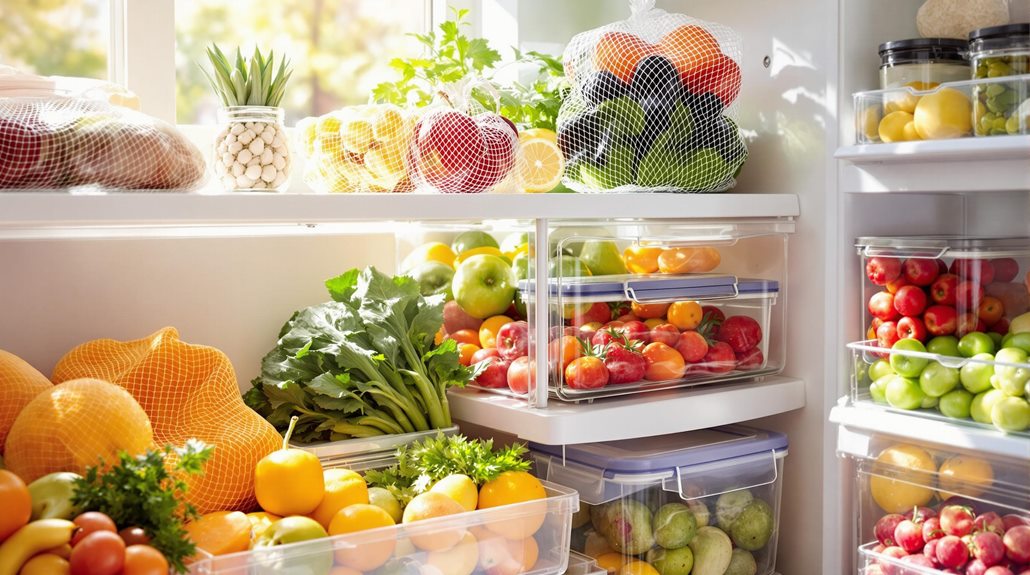
To store fresh produce and extend its shelf life, pay attention to each item's unique needs. Choose firm, colorful fruits and vegetables without blemishes. Store potatoes in a cool, dark place, and keep leafy greens in breathable bags at 40°F. Always separate ethylene-producing produce like apples from sensitive items to avoid premature ripening. Use the fridge for berries and wrap root veggies in damp towels inside airtight containers. Avoid plastic for room-temperature storage to prevent moisture buildup. Control humidity levels for ideal freshness. With a few more tips, your produce can stay fresher, saving you time and reducing waste.
Selecting Quality Produce
Selecting high-quality produce is vital for guaranteeing freshness and prolonging shelf life. When you're selecting leafy greens, make certain to look for rich colors. Avoid any greens with limp or yellowing leaves, as these signs indicate reduced freshness and quality. For root vegetables, cabbages, squash, and onions, they should feel heavy for their size. This weightiness is a good indicator of their freshness. Also, make certain they're free from blemishes to guarantee peak quality.
When you're in the store, opt for produce types that have longer shelf lives. Winter squashes and root vegetables are great choices that help reduce waste and enhance freshness. This way, you'll have more time to consume them without worrying about spoilage. It's vital to familiarize yourself with the specific storage needs of different produce types. Understanding these needs allows you to maintain their quality and effectively extend their shelf life.
General Storage Conditions
To improve the freshness and longevity of your produce, pay attention to general storage conditions like temperature, ethylene gas, and airflow. Start by recognizing the right temperature for different items. Refrigeration is beneficial for many fruits and vegetables, but some, like potatoes and onions, prefer a cool, dark spot outside the fridge. This guarantees they maintain their quality and don't spoil prematurely.
Understanding ethylene gas is vital. It accelerates ripening, so you'll want to separate ethylene-producing items, such as apples and bananas, from ethylene-sensitive produce like leafy greens and berries. This simple storage adjustment can drastically extend their shelf life.
Airflow plays a significant role in maintaining freshness. Avoid using plastic bags for produce stored at room temperature, as they trap moisture, leading to spoilage. Instead, provide proper airflow around your produce to prevent moisture buildup.
For those items stored in the fridge, use sealed containers to retain necessary moisture while protecting them from ethylene exposure. This method keeps your produce crisp and fresh longer. By managing these factors—temperature, ethylene gas, and airflow—you'll optimize the shelf life and quality of your fresh produce.
Managing Ethylene Gas
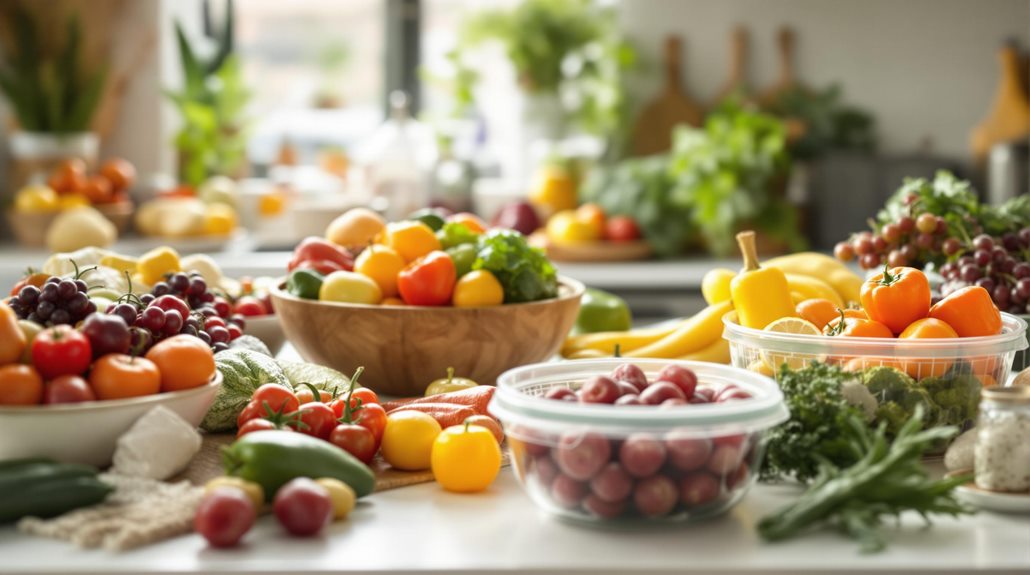
When you're managing ethylene gas in your produce storage, understanding its effects is crucial for maintaining freshness. Ethylene is a natural plant hormone that speeds up the ripening process of fruits and vegetables, which can quickly reduce their shelf life. Certain fruits, like apples, bananas, and tomatoes, are high ethylene producers. If you store these fruits near ethylene-sensitive items such as leafy greens and broccoli, they can cause premature ripening and spoilage.
To effectively manage ethylene gas, separate your high ethylene-producing fruits from ethylene-sensitive vegetables. This simple step can greatly enhance the shelf life of your fresh produce. Furthermore, guarantee proper ventilation and airflow in your storage areas. This will help disperse the ethylene gas, reducing its impact on sensitive produce. By organizing your storage space with these characteristics in mind, you can optimize freshness and minimize food waste.
Potatoes and Sweet Potatoes
While managing ethylene gas is crucial for many types of produce, potatoes and sweet potatoes have unique storage needs that help maintain their quality and longevity. To store your potatoes effectively, find a cool, dark place with temperatures between 40-50°F. This environment prevents greening and sprouting, guaranteeing they last longer. Avoid refrigeration, as it can negatively affect their flavor and texture. Sweet potatoes require similar storage conditions but typically have a shorter shelf life, lasting about 1-2 weeks.
Because both potatoes and sweet potatoes are ethylene-sensitive, keep them away from ethylene-producing items like onions and bananas. Exposure to ethylene gas can accelerate spoilage and sprouting, diminishing their quality. To further prolong their shelf life, verify high humidity and good air circulation in the storage area. You can use paper bags to absorb excess moisture, which helps maintain the right humidity levels.
If your potatoes sprout, don't worry—they're still safe to eat if they're firm. Just cut off the sprouts before cooking. By following these storage tips, you'll keep your potatoes and sweet potatoes fresh and ready for your next culinary creation.
Storing Other Root Vegetables
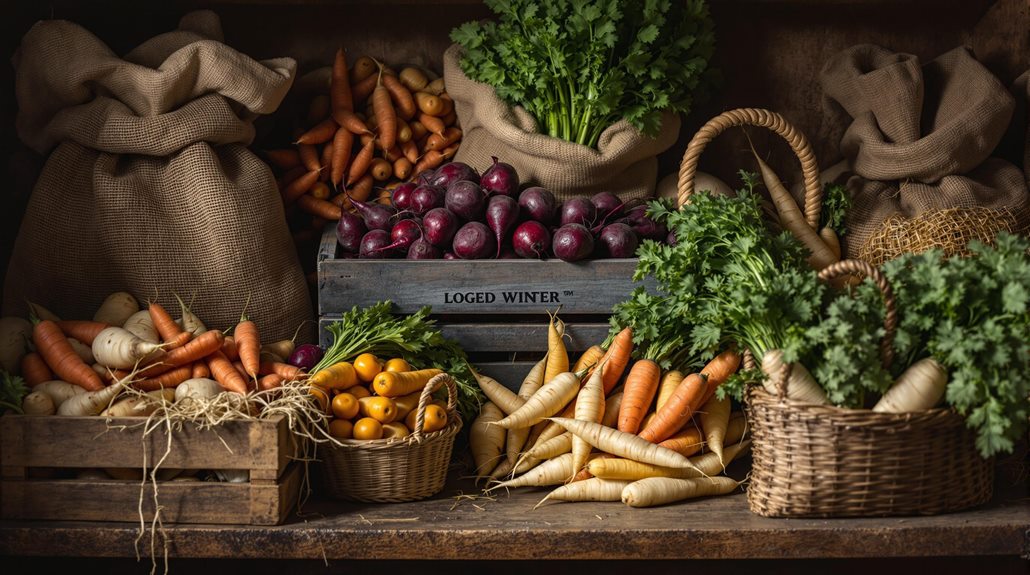
Root vegetables like carrots, beets, and radishes require specific storage conditions to retain their freshness and flavor. Start by removing the leafy tops, as they draw moisture from the roots, leading to wilting. Once you've trimmed them, store these root vegetables in your refrigerator to extend freshness. Use perforated plastic bags or place them loosely in the crisper drawer. This setup helps maintain the right level of moisture, essential for keeping these veggies fresh for weeks.
Make certain you keep root vegetables away from ethylene-producing fruits like apples and bananas. Ethylene gas can accelerate softening or cause sprouting, leading to premature spoilage. To further protect and store them, consider wrapping your root vegetables in damp paper towels and putting them in an airtight container. This method guarantees moisture control, which is important to prevent rot.
Carrots can last up to three weeks, while beets can stay fresh for a month. Radishes, however, should be consumed within two to three weeks for the best taste and texture. Following these storage tips will help you enjoy your root vegetables longer and reduce food waste.
Onions and Garlic Storage
Although onions and garlic are kitchen staples, storing them correctly is crucial to preserving their flavor and longevity. To keep them fresh for weeks or even months, store onions and garlic in a cool, dark, and well-ventilated area. This environment helps prevent spoilage and maintains their quality. Remember, these bulbs are moisture-sensitive, so it's significant to keep them away from items like potatoes, which release ethylene gas and can accelerate spoilage.
If you notice your onions or garlic starting to sprout, don't worry—they're still safe to consume. Just cut off the shoots before use, and they're good to go. For leftover cut onions, refrigeration is key. Place them in sealed containers to prevent odor spread and maintain their freshness.
However, avoid refrigerating whole onions and garlic. The humidity inside the fridge can cause mold growth and lead to a deterioration of flavor. Keeping them in a well-ventilated area outside the fridge will guarantee they stay fresher longer. By following these storage tips, you'll enhance the shelf life of your onions and garlic, making sure they're always ready for your next culinary creation.
Proper Fruit Storage
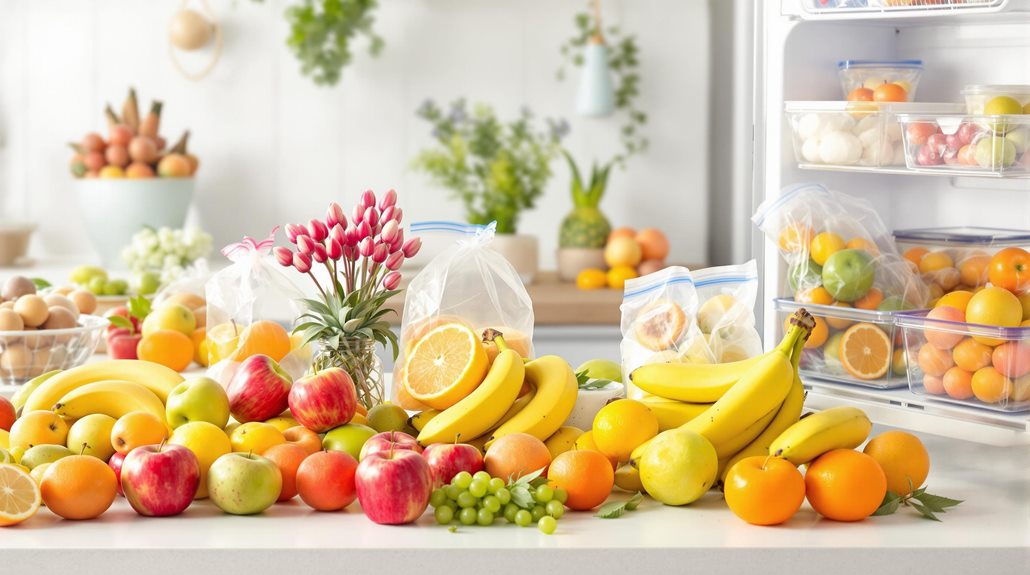
With regard to keeping your fruit fresh and flavorful, proper storage is key. To properly store fresh fruits, consider the specific needs of each type. Apples, for instance, should be stored in the fridge in plastic bags to maintain crispness for a couple of weeks. Pears, after ripening at room temperature, can stay in the fridge for up to three weeks. When dealing with ethylene-sensitive produce, like mangoes, keep them away from ethylene producers such as apples to extend the shelf life.
Here's a quick reference for storing some popular fruits:
| Fruit | Storage Method |
|---|---|
| Apples | Refrigerate in plastic bags |
| Pears | Ripen at room temp, then refrigerate |
| Mangoes | Unripe: room temp on a towel; Ripe: refrigerate |
Berries thrive in low humidity when stored in the fridge and can last up to 7 days. Using zip-top bags or airtight containers can further protect them from moisture. Citrus fruits are versatile and can be stored on the countertop or in the fridge to extend their freshness. Ultimately, tomatoes should be left to ripen at room temperature for the best flavor but refrigerate them once ripe to save storage space and extend their usability.
Storing Leafy Greens
Preservation is key regarding keeping your leafy greens fresh and flavorful. Start by storing leafy greens unwashed in a breathable container or a zip-top plastic bag. This helps maintain their moisture and crispness, vital for extending their shelf life. Make sure your refrigerator is set to around 40°F, which is ideal for most greens. When you bring them home, remove wilted leaves immediately to prevent spoilage of the healthy ones.
Different greens have different storage needs. Hardier greens like kale can stay fresh for up to two weeks. However, tender greens such as arugula and spinach are best eaten quickly for peak taste and texture. If you need to store greens for a longer period, consider blanching them for 2-3 minutes before freezing. This process locks in both nutrients and flavor, allowing for long-term storage of up to 6-8 months.
Be mindful of where you store your leafy greens in your fridge. Keep them away from ethylene-producing fruits like apples and bananas, which can cause premature wilting. By following these steps, you'll enhance the freshness and longevity of your greens.
Winter Squashes Techniques
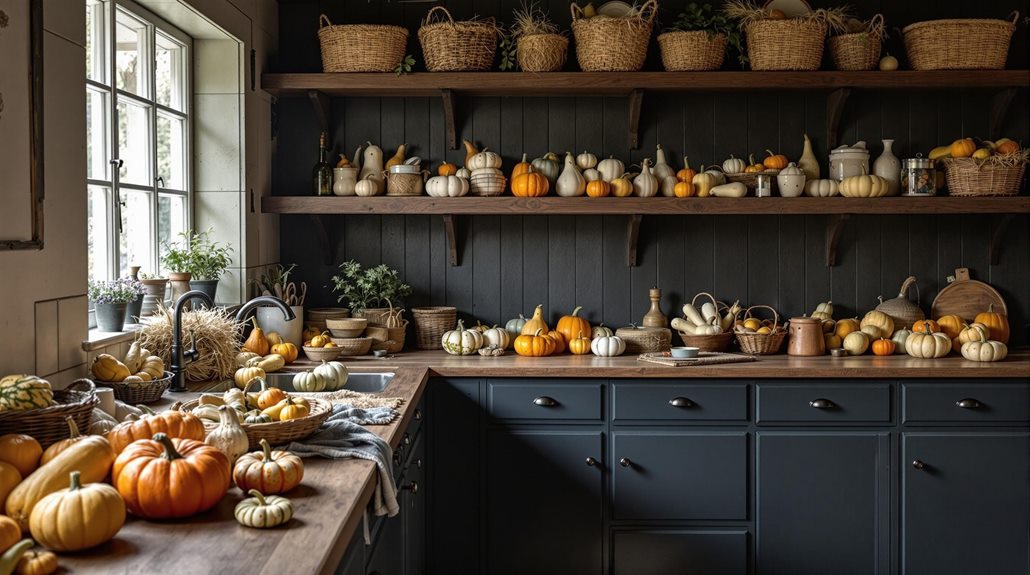
Winter squash's resilience makes it a staple for long-term storage in your kitchen. To enhance their shelf life, store winter squashes like butternut and acorn in a cool, dry place with ample air circulation. This setup can help them last for several months. The thick-skinned varieties, such as Hubbard or butternut, can be kept for up to six months if stored correctly, whereas thinner-skinned types like acorn should be eaten within one to two months.
Be mindful of ethylene-producing fruits like bananas and apples, as they can cause your squashes to ripen prematurely and spoil. Keep these fruits separate to maintain peak quality. Regularly check your stored squashes for any spots or blemishes. If you notice any, treat them with a gentle bleach solution to help prevent spoilage and extend their usability.
For leftover squash portions, peel them and place them in sealed containers before refrigerating. This method will keep them fresh for up to a week. By following these techniques, you can enjoy the rich flavors and nutritional benefits of winter squashes for months, ensuring they remain a valuable part of your meals.
Avoiding Spoilage and Waste
Taking proactive steps to avoid spoilage and waste in your kitchen can greatly extend the life of your fresh produce. Start by separating ethylene-producing fruits like apples and bananas from ethylene-sensitive vegetables such as leafy greens and broccoli. This simple adjustment can dramatically reduce spoilage and enhance the shelf life of your produce. Also, pay attention to humidity levels when storing fresh items. Leafy greens and root vegetables thrive in high humidity, while onions and garlic prefer low humidity to prevent moisture loss and keep them fresh longer.
Implement the FIFO (First In, First Out) method in your inventory management. By using older produce initially, you'll minimize the risk of spoilage and waste. Regularly check your stored produce for any signs of spoilage, like mold or wilting. Removing affected items promptly prevents them from spreading spoilage to other fresh produce.
Moreover, use proper storage techniques to maintain freshness. Wrap celery in aluminum foil to lock in moisture, and keep cucumbers dry to prolong their shelf life. By following these guidelines, you'll optimize your produce's freshness and reduce unnecessary waste in your kitchen.

